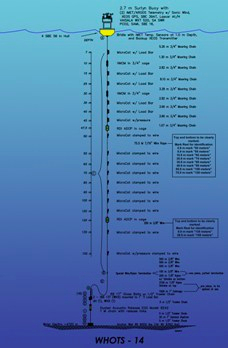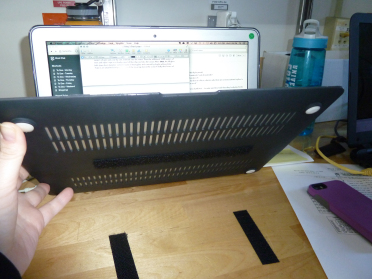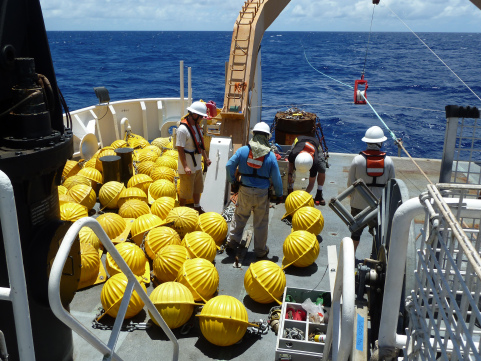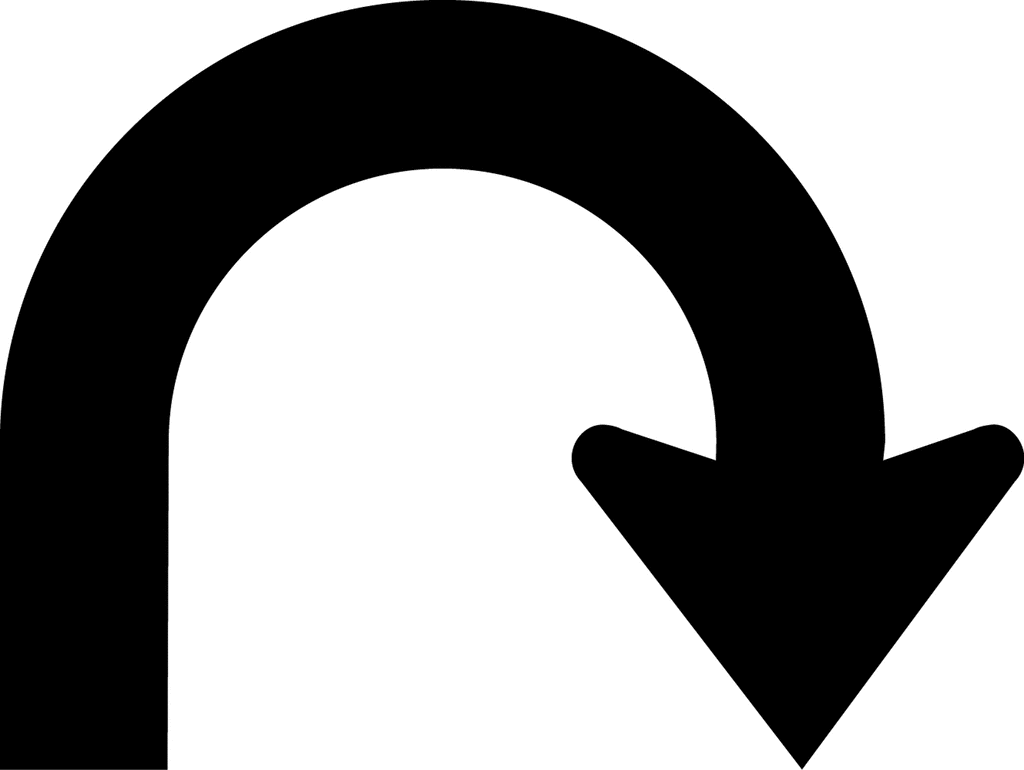NOAA Teacher at Sea
Samantha Adams
Aboard NOAA Ship Hi’ialakai
July 25 – August 8, 2017
Mission: Woods Hole Oceanographic Institution (WHOI) Hawaii Ocean Time-series Station deployment (WHOTS-14)
Geographic Area of Cruise: Hawaii, Pacific Ocean
Date: Thursday, 27 July 2017
Weather Data from the Bridge:
Latitude & Longitude: 22.38oN, 158.01oW. Ship speed: 1.3 knots. Air temperature: 27.7oC Sea temperature: 27.1oC. Humidity: 75%.Wind speed: 12.9 knots. Wind direction: 59.7 degrees. Sky cover: Scattered.
Science and Technology Log:
It’s deployment day! After months of preparation and days of practice, this buoy is finally going in the water!
The sheer volume of stuff that’s involved is mind boggling. There’s the buoy itself, which is nearly 3 meters (approximately 9 feet) tall; one meter of that sits below the surface. There’s 16 MicroCats (which are instruments measuring temperature, salinity and depth of the water) attached to over 350 meters of chain and wire. Then there’s another 1,800 meters of wire and 3,600 meters of two different types of line (rope) — heavy nylon and polypropylene. Then there’s 68 glass balls, for flotation. After that, there’s another 35 meters of chain and nylon line. Attached to that is an acoustic release, which does exactly what it sounds like it does — if it “hears” a special signal, it detaches from whatever is holding it down. In this case, that’s a 9,300 pound anchor. (The acoustic release and the glass balls make sure that all the instruments on the mooring line can be recovered.) All in all, nearly 6,000 meters — three and a half miles — of equipment and instrumentation is going over the stern of the Hi’ialakai. The length of the mooring line is actually longer (approximately one and a quarter times longer) than the ocean is deep where the buoy is being deployed. This is done so that if (or when) the buoy is pulled by strong winds or currents, there is extra “space” available to keep the buoy from getting pulled under water.

Diagram of the WHOTS station. Notice how many instruments are on the mooring line, below the surface! Photo courtesy of the University of Hawai’i.
Take a look at the diagram of the WHOTS-14 buoy. It’s easy to assume that the everything goes into the water in the exact same order as is shown on the diagram — but the reality of deployment is actually very different.
First, the MicroCats that are attached to the first 30 meters of chain (6 of them) go over the side. Approximately the first five meters of chain stay on board, which is then is attached to the buoy. After that, the buoy is hooked up to the crane, and gently lifted off the deck, over the side, and into the water. Then, the remaining ten MicroCats are attached, one by one, to the 325 meters of wire and, one by one, lowered into the water. Then the additional 3,400 meters of wire and nylon line are slowly eased off the ship and into the ocean. After that, the glass balls (two-foot diameter spheres made of heavy glass and covered by bright yellow plastic “hats”) are attached and join the rest of the mooring line in the ocean. Finally, after hours of hard work, the end of the mooring line is attached to the anchor. Then, with a little help from the ship’s crane, the anchor slides off the stern of the ship, thunks into the water, and slowly starts making its way to the bottom.
4:18PM HAST: Splashdown! The anchor is dropped.
From the morning-of preparations to the anchor sliding off the Hi’ialakai’s stern, deploying the WHOTS buoy took 9 hours and 41 minutes.
Personal Log:

My laptop, secured for sea!
Another item to file under Things You Never Think About: Velcro is awesome. Ships — all ships, even one the size of the Hi’ialakai — frequently move in unexpected, jarring ways. (If you’ve never been on a ship at sea, it’s a bit like walking through the “Fun House” at a carnival — one of the ones with the moving floors. You try to put your foot down, the floor drops a few inches underneath you, and you’re suddenly trying to walk on air.) For this reason, it’s important to keep everything as secured as possible. Rope and straps are good for tying down things that can stay in one place, but something like a laptop, which needs to be mobile? Velcro!
Did You Know?

Getting ready to attach the glass balls to the mooring line. The light blue Colmega is in the upper right hand corner of the picture, trailing out behind the ship. The buoy, at the end of over three miles of mooring line, is no longer visible.
Not all line is created equal. Aside from obvious differences in the size and color, different lines have different purposes. The heavy nylon line (which is white; see the picture in slideshow of the line being deployed) is actually able to stretch, which is another safety precaution, ensuring that the buoy will not be pulled under water. The light blue polypropylene line, called Colmega, floats. In the picture to the left, you can see a light blue line floating in the water, stretching off into the distance. It’s not floating because it’s attached to the ship — it’s floating all by itself!
Share this:





